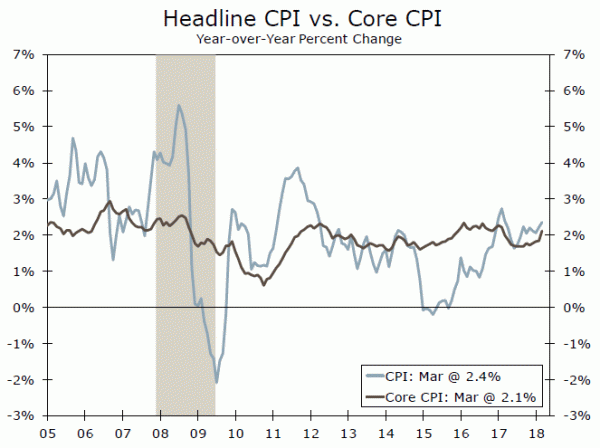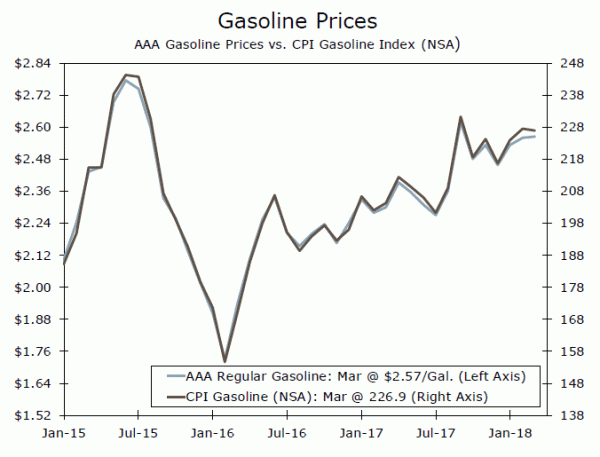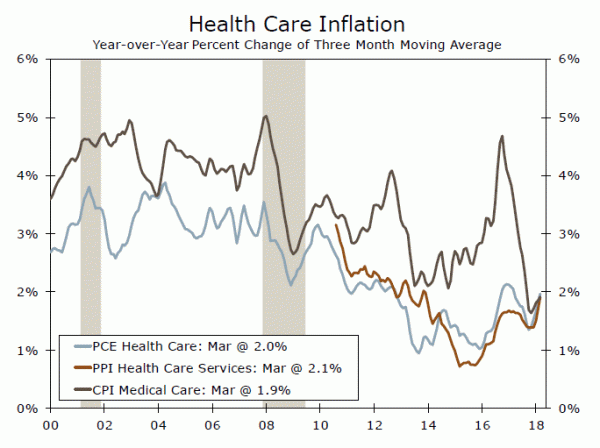CPI should bounce back 0.3 percent in April due to higher energy prices, while the core index is likely to print a trend-like 0.2 percent gain. Both indexes should rise on a year-ago basis in another sign inflation is picking up.
Headline CPI to Rebound, Trend-like Gain for Core CPI in April
We expect headline CPI to rebound 0.3 percent in April after a gasolineinduced decline in March. That should push the year-ago change up to 2.5 percent. Our model predicts the non-seasonally adjusted index rising to 250.49.
Core inflation is likely to print 0.2 percent for a third straight month. We view the risk to that call as lying to the downside, however, with an expectation that April will be a “low” 0.2 percent gain. Nevertheless, the core CPI should rise to 2.2 percent year over year. Unlike recent months, we do not expect the latest seasonal adjustment factors or residual seasonality to have a meaningful impact to the core index. Over the past five years, the core index has increased an average of 0.148 in April, only modestly lower than the 0.156 percent average change for all months.
What We’ll be Watchingn
Gasoline Prices Revving Up: Gasoline prices jumped 6.2 percent in April, according to AAA. Gains this time of year, however, are fairly typical, so we expect energy prices to contribute only about 0.1 percentage point to the headline change. That follows a 0.2 percentage point drag in March when the CPI NSA series fell more than both AAA and EIA measures indicated.
Is the energy component of CPI therefore susceptible to a bigger gain than indicated by AAA to bring it more in line with other measures of gas prices? Never say never when it comes to the potential for monthly economic data to surprise, but we do not view it as a major risk. As shown in the middle chart, the CPI index for gasoline runs quite closely with AAA prices, but has been a bit stronger of late. Last month’s softer reading in the CPI series brought it more closely in line with AAA prices.
Heart Palpitations from Medical Costs: Medical care costs rose 0.4 percent in March—twice as fast as its average gain over the past year. While that may invite some payback in April, other measures of healthcare inflation are showing costs picking up after what has been some of the most restrained growth in decades (bottom chart). Medical costs in the CPI bears a little less than half the weight than in the PCE deflator—the Fed’s benchmark for its 2 percent inflation target—and is limited to consumers’ out-of-pocket costs. But with nearly a 9 percent weighting, the renewed strength in medical costs stands to be an important source of upward pressure on core CPI.
Room for Rent: Shelter costs bounced back in March, led by the owner’s equivalent rent (OER) and lodging away from home components. While low inventories of homes for sale should keep OER growth solid, it would not be a big surprise to see prices soften in the volatile hotel sector. Prices for rented primary residences also picked up in March, but are beginning to show signs of coming under pressure from the immense growth in multifamily units the past couple of years.

















